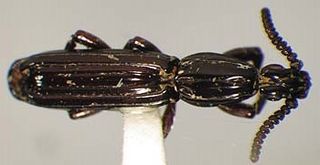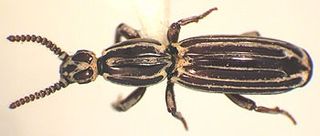
Clinidium is a genus of wrinkled bark beetles in the subfamily Rhysodinae. Most species are Neotropical, but some occur further north in North America and there is also one species in Europe and one in Japan. Two species are known from Miocene amber.
Arrowina is a genus of wrinkled bark beetles in the family Carabidae. The genus occurs in Asia, with records from at least Sri Lanka, southern India, Nepal, Thailand, Sumatra (Indonesia), and Japan.

Kaveinga is a genus of wrinkled bark beetles in the family Carabidae.
Omoglymmius feae is a species of beetle in the subfamily Rhysodidae. It was described by Antoine Henri Grouvelle in 1895. It is known from the type series collected by Leonardo Fea in Myanmar in 1888.
Clinidium beccarii is a species of ground beetle in the subfamily Rhysodinae. It was described by Antoine Henri Grouvelle in 1903. It is known from Hatam, New Guinea. It is named after the collector of the holotype, Odoardo Beccari. The holotype is a male measuring 8 mm (0.31 in) in length.
Clinidium centrale is a species of ground beetle in the subfamily Rhysodinae. It was described by Antoine Henri Grouvelle in 1903. It is endemic to Costa Rica. Clinidium centrale measure 6–7.4 mm (0.24–0.29 in) in length.
Clinidium dubium is a species of ground beetle in the subfamily Rhysodinae. It was described by Antoine Henri Grouvelle in 1903. It is known from Loja, Ecuador. The holotype measures 5.7 mm (0.22 in) in length.
Clinidium foveolatum is a species of ground beetle in the subfamily Rhysodinae. It was described by Antoine Henri Grouvelle in 1903. It is known from Ecuador.
Clinidium insigne is a species of ground beetle in the subfamily Rhysodinae. It was described by Antoine Henri Grouvelle in 1903. It is known from Ecuador, provisionally from Cali, Colombia, and Yacambú National Park in Venezuela.
Clinidium mathani is a species of ground beetle in the subfamily Rhysodinae. It was described by Antoine Henri Grouvelle in 1903. Originally known from the Amazon Basin of Brazil—its type locality is in the Amazonas State, near the border with Peru and Colombia, and there is another record from Amapá—it is now also known from the Colombian Andes in the Cordillera de los Picachos National Natural Park (Caquetá) and from near Inzá (Cauca). It is named after collector of the holotype, M. de Mathan.
Clinidium pilosum is a species of ground beetle in the subfamily Rhysodinae. It was described by Antoine Henri Grouvelle in 1903. It is known from Mérida state in western Venezuela, possibly extending into adjacent Colombia.
Clinidium validum is a species of ground beetle in the subfamily Rhysodinae. It was described by Antoine Henri Grouvelle in 1903. It is widespread in the Amazon Basin of Brazil with records from Amazonas, Pará, and Amapá states. Clinidium validum measure 5.8–6.4 mm (0.23–0.25 in) in length.

Rhyzodiastes bifossulatus is a species of ground beetle in the subfamily Rhysodinae. It was described by Antoine Henri Grouvelle in 1903. It is found in Borneo, with confirmed records from Sabah (Malaysia).

Rhyzodiastes frater is a species of ground beetle in the subfamily Rhysodinae. It was described by Antoine Henri Grouvelle in 1903. It is found in Borneo, with records from both Sarawak (Malaysia) and Kalimantan (Indonesia).

Rhyzodiastes gestroi is a species of ground beetle in the subfamily Rhysodinae. It was described by Antoine Henri Grouvelle in 1903. It is found on Sumatra (Indonesia).
Rhyzodiastes guineensis is a species of ground beetle in the subfamily Rhysodinae. It was described by Antoine Henri Grouvelle in 1903. It is found in New Guinea, with records from both Papua New Guinea and Western New Guinea.
Rhyzodiastes raffrayi is a species of ground beetle in the subfamily Rhysodinae. It was described by Antoine Henri Grouvelle in 1895. It is known from the holotype collected on Halmahera, in the Maluku Islands of Indonesia. The holotype measures 5.3 mm (0.21 in) in length.
Rhyzodiastes sulcicollis is a species of ground beetle in the subfamily Rhysodinae. It was described by Antoine Henri Grouvelle in 1903. It is found in the central parts of the Caroline Islands, in the Chuuk and Yap states of the Federated States of Micronesia. Rhyzodiastes sulcicollis measure 4–6.5 mm (0.16–0.26 in) in length.
Rhyzodiastes waterhousii is a species of ground beetle in the subfamily Rhysodinae. It was described by Antoine Henri Grouvelle in 1910. It is found in Myanmar.
Clinidium oberthueri is a species of ground beetle in the subfamily Rhysodinae. It was described by Antoine Henri Grouvelle in 1903. It is known from Ecuador where it is known with certainty from the eastern side of the Andes, and from Barbacoas, Nariño, on the other versant of the Andes in Colombia.




